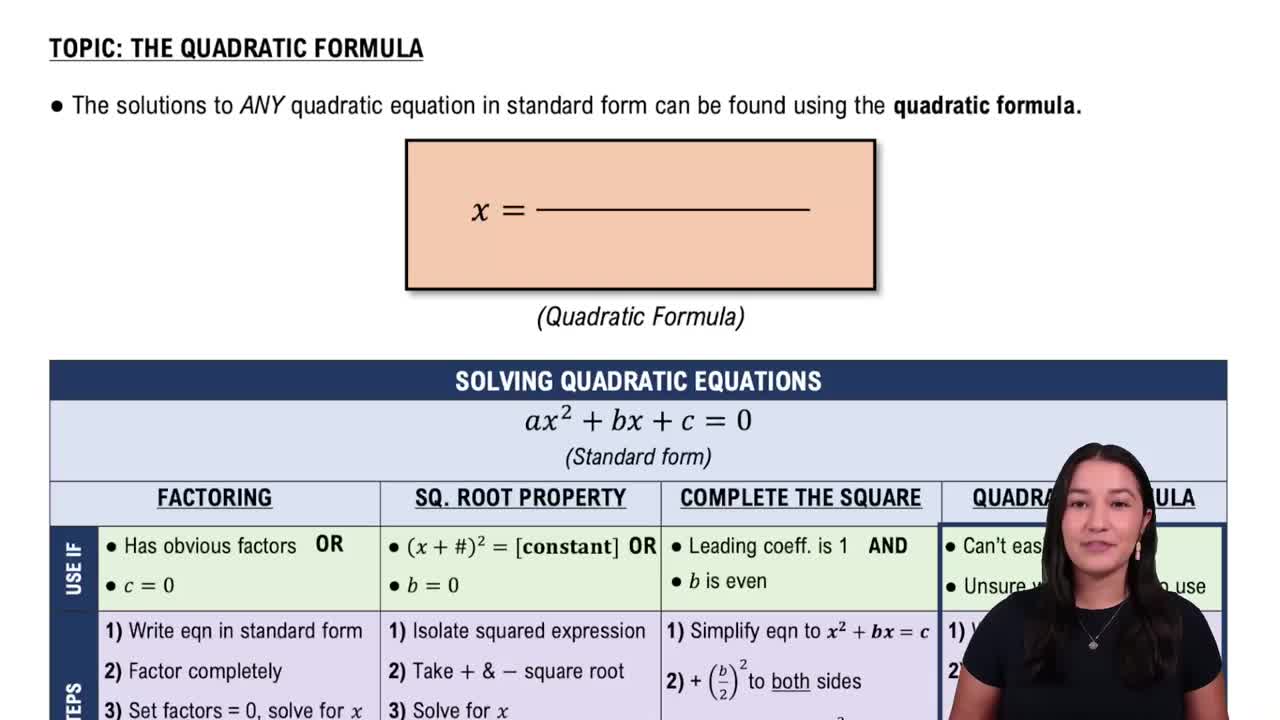Table of contents
- 0. Review of Algebra4h 16m
- 1. Equations & Inequalities3h 18m
- 2. Graphs of Equations43m
- 3. Functions2h 17m
- 4. Polynomial Functions1h 44m
- 5. Rational Functions1h 23m
- 6. Exponential & Logarithmic Functions2h 28m
- 7. Systems of Equations & Matrices4h 6m
- 8. Conic Sections2h 23m
- 9. Sequences, Series, & Induction1h 19m
- 10. Combinatorics & Probability1h 45m
4. Polynomial Functions
Zeros of Polynomial Functions
Problem 83a
Textbook Question
Exercises 82–84 will help you prepare for the material covered in the next section. Solve: x^2+4x+6=0
 Verified step by step guidance
Verified step by step guidance1
<Step 1: Identify the type of equation.> The given equation is a quadratic equation of the form \( ax^2 + bx + c = 0 \), where \( a = 1 \), \( b = 4 \), and \( c = 6 \).
<Step 2: Determine the method to solve the quadratic equation.> Since the equation does not factor easily, use the quadratic formula: \( x = \frac{-b \pm \sqrt{b^2 - 4ac}}{2a} \).
<Step 3: Calculate the discriminant.> Compute \( b^2 - 4ac \) to determine the nature of the roots. Substitute \( b = 4 \), \( a = 1 \), and \( c = 6 \) into the discriminant formula: \( 4^2 - 4 \times 1 \times 6 \).
<Step 4: Evaluate the discriminant.> Simplify the expression \( 16 - 24 \) to find the value of the discriminant.
<Step 5: Analyze the discriminant.> Since the discriminant is negative, the quadratic equation has two complex conjugate roots. Proceed to use the quadratic formula to find these roots.
Recommended similar problem, with video answer:
 Verified Solution
Verified SolutionThis video solution was recommended by our tutors as helpful for the problem above
Video duration:
3mPlay a video:
Was this helpful?
Key Concepts
Here are the essential concepts you must grasp in order to answer the question correctly.
Quadratic Equations
A quadratic equation is a polynomial equation of the form ax^2 + bx + c = 0, where a, b, and c are constants, and a ≠ 0. The solutions to these equations can be found using various methods, including factoring, completing the square, or applying the quadratic formula. Understanding the structure of quadratic equations is essential for solving them.
Recommended video:

Introduction to Quadratic Equations
The Quadratic Formula
The quadratic formula, x = (-b ± √(b² - 4ac)) / (2a), provides a method for finding the roots of any quadratic equation. The term under the square root, known as the discriminant (b² - 4ac), determines the nature of the roots: if it's positive, there are two distinct real roots; if zero, one real root; and if negative, two complex roots. This formula is crucial for solving the given equation.
Recommended video:

Solving Quadratic Equations Using The Quadratic Formula
Completing the Square
Completing the square is a method used to solve quadratic equations by rewriting them in the form (x + p)² = q. This technique involves manipulating the equation to create a perfect square trinomial, which can then be solved easily. It is particularly useful when the quadratic formula is not preferred or when deriving the vertex form of a parabola.
Recommended video:

Solving Quadratic Equations by Completing the Square




